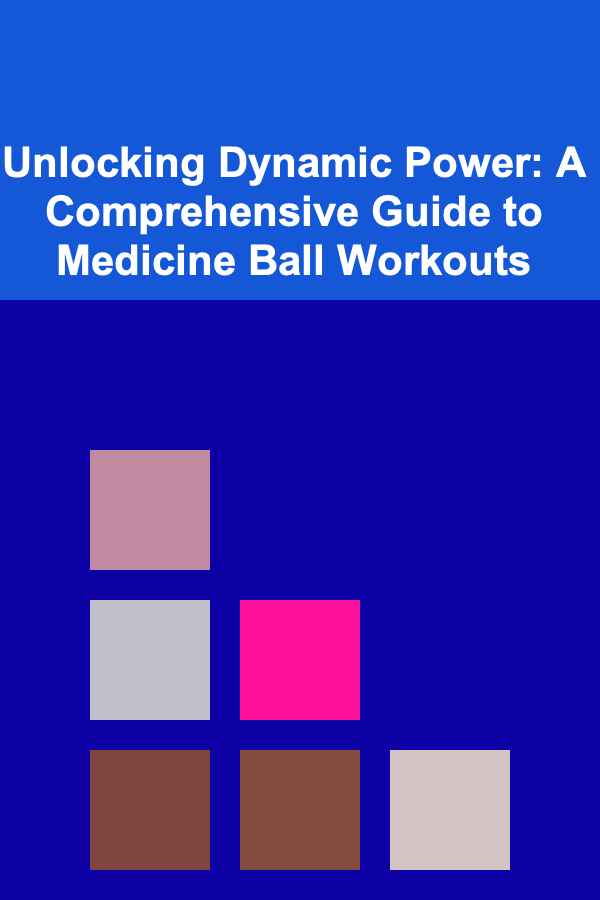
Unlocking Dynamic Power: A Comprehensive Guide to Medicine Ball Workouts
ebook include PDF & Audio bundle (Micro Guide)
$12.99$11.99
Limited Time Offer! Order within the next:

Medicine balls, weighted spheres ranging from a few pounds to over twenty, are versatile training tools that have been used for centuries to improve strength, power, coordination, and overall fitness. They offer a unique approach to resistance training compared to traditional weights, allowing for dynamic, multi-planar movements that closely mimic real-world activities and athletic demands. This article will delve into the multifaceted benefits of medicine ball training, explore a variety of exercises for different fitness goals, and provide practical guidance on incorporating them effectively into your workout routine.
The Power of Dynamic Movement: Why Medicine Balls?
Traditional weightlifting often focuses on isolated muscle groups and linear movements. While effective for building raw strength, this approach can sometimes neglect the coordination and integrated movement patterns necessary for functional fitness and athletic performance. Medicine balls, on the other hand, excel at promoting dynamic, multi-planar movements that engage multiple muscle groups simultaneously.
Here's why medicine balls are a valuable addition to any fitness program:
- Enhanced Power Development: Medicine ball throws and slams are excellent for developing explosive power, which is crucial for activities like jumping, sprinting, and throwing. The ballistic nature of these movements recruits fast-twitch muscle fibers and improves the rate of force development.
- Improved Core Strength and Stability: Many medicine ball exercises require significant core engagement to stabilize the body and control the movement. This translates to improved core strength, stability, and posture.
- Increased Coordination and Proprioception: Medicine ball exercises challenge your body's ability to coordinate movements and maintain balance. This improves proprioception (awareness of your body in space) and enhances overall movement efficiency.
- Functional Strength: Medicine ball movements often mimic real-world activities, making them a valuable tool for building functional strength. For example, a medicine ball chop mimics the movement of swinging an axe or rotating during a tennis swing.
- Variety and Engagement: Medicine ball workouts can be incredibly varied and engaging, preventing boredom and keeping you motivated. The possibilities are virtually endless, allowing you to target specific muscle groups and movement patterns.
- Accessibility and Portability: Medicine balls are relatively inexpensive and easy to transport, making them a convenient option for home workouts or travel.
Choosing the Right Medicine Ball: Weight and Material
Selecting the appropriate medicine ball is crucial for safety and effectiveness. Consider the following factors when making your choice:
Weight
The ideal weight depends on your fitness level, the exercise being performed, and your specific goals. As a general guideline:
- Beginners: Start with a lighter ball (4-8 lbs) to focus on technique and coordination.
- Intermediate: Progress to a moderate weight (8-12 lbs) to challenge your strength and power.
- Advanced: Use heavier balls (12+ lbs) for exercises that require significant power and strength.
It's better to start with a lighter weight and gradually increase it as you become more comfortable and proficient with the exercises. Focus on maintaining proper form throughout the entire range of motion.
Material
Medicine balls come in various materials, each with its own advantages and disadvantages:
- Rubber: Durable and versatile, suitable for a wide range of exercises, including slams and throws. Good grip and bounce.
- Leather/Synthetic Leather: Provides a good grip and a more traditional feel. Generally more expensive and may require more maintenance. Less suitable for slams as the stitching can be damaged.
- Gel-Filled: Softer and more pliable, often used for rehabilitation exercises or for those with sensitive joints. Less suitable for high-impact throws.
- Wall Balls: Specifically designed for wall throws, often larger and softer than other types of medicine balls. Made to absorb impact against a wall.
Consider the exercises you plan to perform most frequently when choosing the material. Rubber medicine balls are a good all-around option for most people.
Medicine Ball Exercises: A Comprehensive Guide
This section provides a detailed overview of various medicine ball exercises, categorized by target muscle groups and movement patterns. Remember to warm up properly before starting any workout and cool down afterwards.
Core Exercises
Russian Twists
Muscles Targeted: Obliques, rectus abdominis, transverse abdominis.
Instructions: Sit on the floor with your knees bent and feet slightly off the ground. Hold the medicine ball with both hands in front of you. Rotate your torso from side to side, touching the medicine ball to the floor on each side. Keep your back straight and engage your core throughout the exercise. To increase the difficulty, lean back further.
Medicine Ball Sit-Ups
Muscles Targeted: Rectus abdominis, obliques.
Instructions: Lie on your back with your knees bent and feet flat on the floor. Hold the medicine ball with both hands above your chest. Perform a sit-up, lifting your torso off the floor and reaching the medicine ball towards your knees. Slowly lower back down to the starting position. Focus on controlled movement and avoid using momentum.
Medicine Ball Plank
Muscles Targeted: Entire core, including rectus abdominis, transverse abdominis, obliques, and lower back muscles.
Instructions: Assume a plank position with your forearms on the floor and your body in a straight line from head to heels. Place the medicine ball under your forearms, increasing the instability. Engage your core and maintain a straight line throughout the exercise. Start with short holds and gradually increase the duration as you get stronger. A variation is to place the medicine ball under your feet.
Wood Chops
Muscles Targeted: Obliques, core, shoulders, legs.
Instructions: Stand with your feet shoulder-width apart and hold the medicine ball with both hands. Rotate your torso and bring the medicine ball down and across your body towards the outside of one leg, as if chopping wood. Return to the starting position and repeat on the opposite side. Keep your core engaged and your back straight throughout the exercise. Control the movement; don't let momentum take over.
Upper Body Exercises
Medicine Ball Chest Pass
Muscles Targeted: Chest, shoulders, triceps.
Instructions: Stand facing a wall or a partner, with your feet shoulder-width apart. Hold the medicine ball close to your chest. Push the medicine ball forward towards the wall or your partner, using your chest and arms. Catch the ball and repeat. Focus on explosive power and maintaining good form. Adjust the distance based on your strength and power.
Overhead Medicine Ball Throw
Muscles Targeted: Shoulders, triceps, core, upper back.
Instructions: Stand with your feet shoulder-width apart and hold the medicine ball overhead with both hands. Throw the ball down to the ground in front of you, using your entire body to generate power. Catch the ball and repeat. Bend your knees and hinge at the hips as you throw to engage your lower body. This exercise is excellent for developing full-body power.
Medicine Ball Push-Ups
Muscles Targeted: Chest, shoulders, triceps, core.
Instructions: Assume a push-up position with one hand on the medicine ball and the other on the floor. Perform a push-up, lowering your chest towards the floor. Switch hands and repeat. This exercise increases the instability and challenges your core strength. Start with your knees on the ground if needed.
Medicine Ball Slams
Muscles Targeted: Shoulders, core, back, arms.
Instructions: Stand with your feet shoulder-width apart and hold the medicine ball overhead with both hands. Lift the ball overhead, then forcefully slam it down onto the ground. Engage your core and use your entire body to generate power. Catch the ball and repeat. This exercise is great for releasing tension and developing explosive power. Ensure you have a durable medicine ball designed for slams.
Lower Body Exercises
Medicine Ball Squats
Muscles Targeted: Quads, glutes, hamstrings.
Instructions: Stand with your feet shoulder-width apart and hold the medicine ball close to your chest. Perform a squat, lowering your hips towards the floor while keeping your back straight. Return to the starting position and repeat. Holding the medicine ball increases the challenge and engages your core.
Medicine Ball Lunges
Muscles Targeted: Quads, glutes, hamstrings.
Instructions: Stand with your feet shoulder-width apart and hold the medicine ball close to your chest. Step forward with one leg into a lunge, lowering your hips towards the floor. Keep your front knee behind your toes and your back knee close to the ground. Return to the starting position and repeat on the opposite side. The medicine ball adds resistance and challenges your balance.
Medicine Ball Jump Squats
Muscles Targeted: Quads, glutes, hamstrings, calves.
Instructions: Stand with your feet shoulder-width apart and hold the medicine ball close to your chest. Perform a squat, then explosively jump upwards, extending your legs and arms. Land softly and immediately transition into another squat. This exercise develops explosive power in the lower body.
Medicine Ball Leg Raises
Muscles Targeted: Lower abs, hip flexors.
Instructions: Lie on your back with your legs straight and arms extended overhead holding the medicine ball. Keeping your legs straight (or slightly bent if needed), raise them towards the ceiling while simultaneously bringing the medicine ball towards your feet. Aim to touch the ball to your toes. Lower your legs and arms back down slowly and with control. This exercise is challenging and requires good core strength.
Full Body Exercises
Thrusters
Muscles Targeted: Quads, glutes, hamstrings, shoulders, triceps, core.
Instructions: Start in a squat position with the medicine ball held at chest level. As you stand up from the squat, press the medicine ball overhead, extending your arms fully. Lower the ball back to chest level as you return to the squat position. This exercise combines a squat with an overhead press, providing a full-body workout.
Burpees with Medicine Ball
Muscles Targeted: Full body.
Instructions: Stand with your feet shoulder-width apart and hold the medicine ball close to your chest. Squat down and place the medicine ball on the floor in front of you. Kick your feet back into a push-up position. Perform a push-up, then jump your feet back to the squat position. Pick up the medicine ball and jump explosively into the air, raising the ball overhead. This is a challenging and effective full-body exercise.
Creating Your Medicine Ball Workout: Programming and Progression
To design an effective medicine ball workout, consider the following factors:
Goals
What are you hoping to achieve with your medicine ball training? Are you aiming to improve strength, power, core stability, or overall fitness? Tailor your exercises and training parameters to align with your specific goals.
Frequency
How often should you train with medicine balls? A good starting point is 2-3 times per week, allowing for adequate rest and recovery between sessions. You can incorporate medicine ball exercises into your existing strength training program or create dedicated medicine ball workouts.
Sets and Repetitions
The number of sets and repetitions will depend on your goals. Here are some general guidelines:
- Strength: 3-5 sets of 6-8 repetitions with a heavier ball.
- Power: 3-5 sets of 8-12 repetitions with a moderate ball, focusing on explosive movements.
- Endurance: 2-3 sets of 15-20 repetitions with a lighter ball.
Rest
Allow for adequate rest between sets to allow your muscles to recover. A rest period of 60-90 seconds is generally sufficient for strength and power exercises, while a rest period of 30-60 seconds is appropriate for endurance exercises.
Progression
As you get stronger and more proficient with the exercises, it's important to progressively overload your muscles to continue seeing results. Here are some ways to progress your medicine ball training:
- Increase the weight of the medicine ball.
- Increase the number of sets and repetitions.
- Decrease the rest time between sets.
- Increase the intensity of the exercises (e.g., jump higher, throw harder).
- Introduce more challenging variations of the exercises.
- Increase the complexity of the exercises by combining multiple movements.
Sample Medicine Ball Workout
Here's a sample medicine ball workout that you can use as a starting point:
- Warm-up: 5-10 minutes of light cardio and dynamic stretching.
- Medicine Ball Slams: 3 sets of 10 repetitions.
- Russian Twists: 3 sets of 15 repetitions per side.
- Medicine Ball Squats: 3 sets of 12 repetitions.
- Medicine Ball Chest Pass: 3 sets of 15 repetitions.
- Wood Chops: 3 sets of 12 repetitions per side.
- Cool-down: 5-10 minutes of static stretching.
Safety Considerations
While medicine ball training is generally safe, it's important to take certain precautions to minimize the risk of injury:
- Use proper form: Focus on maintaining good form throughout the entire range of motion. If you're unsure about the proper technique, consult with a qualified fitness professional.
- Start with a lighter weight: Gradually increase the weight of the medicine ball as you get stronger.
- Warm up properly: Always warm up before starting your workout to prepare your muscles for exercise.
- Cool down afterwards: Cool down after your workout to help your muscles recover.
- Use a safe environment: Ensure that you have enough space to perform the exercises safely. Avoid training in areas with obstacles or slippery surfaces.
- Listen to your body: If you experience any pain, stop the exercise and consult with a medical professional.
- Choose the right medicine ball for slams: Ensure your medicine ball is designed to withstand impact and won't burst.
Conclusion: Unleash Your Potential with Medicine Ball Training
Medicine balls are powerful tools that can help you unlock your dynamic potential and achieve your fitness goals. By incorporating these versatile training implements into your routine, you can enhance your strength, power, coordination, core stability, and overall functional fitness. Remember to choose the right medicine ball for your needs, focus on proper form, progressively overload your muscles, and prioritize safety. With dedication and consistency, you can reap the numerous benefits of medicine ball training and take your fitness to the next level.

How to Maintain Your Home's Flooring for Longevity
Read More
How to Maximize Small Closet Space with Smart Solutions
Read More
How to Monitor Your Home's Security Remotely
Read More
How to Use Affirmations in Your Decor for Positive Energy
Read More10 Tips for Tracking Ovulation with a Planner
Read More
**10 Tips for Organizing Your Snowboard Instructor Gear**
Read MoreOther Products

How to Maintain Your Home's Flooring for Longevity
Read More
How to Maximize Small Closet Space with Smart Solutions
Read More
How to Monitor Your Home's Security Remotely
Read More
How to Use Affirmations in Your Decor for Positive Energy
Read More10 Tips for Tracking Ovulation with a Planner
Read More